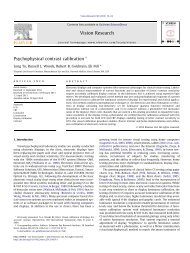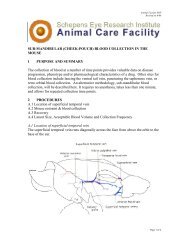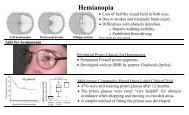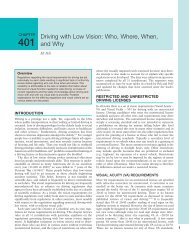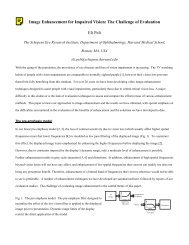In-the-Spectacle-Lens Telescopic Device for Low Vision
In-the-Spectacle-Lens Telescopic Device for Low Vision
In-the-Spectacle-Lens Telescopic Device for Low Vision
Create successful ePaper yourself
Turn your PDF publications into a flip-book with our unique Google optimized e-Paper software.
4. Additional considerations4.1. Field-of-viewThe ocular lens (mirror) of <strong>the</strong> in-<strong>the</strong>-lens telescope is likely to be rectangular in shape. <strong>In</strong><strong>the</strong> horizontal dimension, <strong>the</strong> only limitations on <strong>the</strong> lens size are: <strong>the</strong> dimension of <strong>the</strong> lensitself, <strong>the</strong> spectacle frame, and <strong>the</strong> value chosen <strong>for</strong> <strong>the</strong> telescope length, L. The vertical extent of<strong>the</strong> lenses, however, is limited by <strong>the</strong> carrier lens thickness t. The embedded ocular mirror (M4 inFig. 7) would be <strong>the</strong> field stop, and we can approximate <strong>the</strong> restriction to its vertical size as beingless than or equal to t. A reasonable range of carrier lens thickness would be 5 to 10mm. Forexample, a thickness of 10mm with a 10mm eye relief allows a vertical visual field up to 53° in<strong>the</strong> image space (on <strong>the</strong> retina), which translates to approximately 18° in object space, 50%wider than most current bioptic telescopes. The horizontal FOV (which is less restricted) may beas much as twice as wide as <strong>the</strong> vertical dimension. The horizontal extent of <strong>the</strong> FOV is usuallyconsidered more important <strong>for</strong> navigation and reading, so even thinner carrier lenses would beacceptable.4.2. Light economyThe dimensions chosen <strong>for</strong> <strong>the</strong> carrier lens (e.g. thickness) limit <strong>the</strong> dimensions of <strong>the</strong>objective lens (mirror), which in turn also determine <strong>the</strong> size of <strong>the</strong> exit pupil. The exit pupil sizeis important in determining <strong>the</strong> light efficiency of <strong>the</strong> telescope. When <strong>the</strong> exit pupil completelycovers <strong>the</strong> eye’s pupil <strong>the</strong> light efficiency is maximal at 100%. As stated above, <strong>the</strong> carrier lensthickness limits <strong>the</strong> vertical extent of <strong>the</strong> objective and thus, <strong>the</strong> exit pupil. However, <strong>the</strong>horizontal extent can be much larger and is not constrained by <strong>the</strong> thickness, resulting in a widerectangular shaped objective. The exit pupil, <strong>the</strong> image of <strong>the</strong> objective aperture through <strong>the</strong>ocular, will also have <strong>the</strong> dimensions of <strong>the</strong> objective divided by <strong>the</strong> magnification. Forexample, an entrance pupil of 16×8mm (carrier lens 8mm thick), with a magnification of 3.3×,yields an exit pupil of 4.8×2.4mm. These dimensions may limit <strong>the</strong> amount of light entering <strong>the</strong>25




